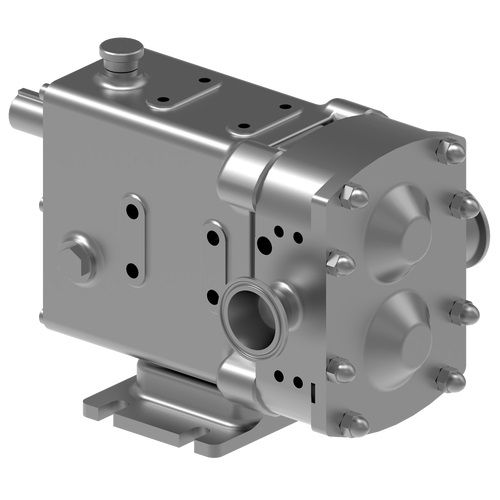An Introduction to Hygienic Pumps
What is a hygienic pump?
Hygienic pumps are specifically designed and manufactured to the highest specifications to minimize the risk of contamination. This is essential in a number of industries which produce products for human consumption or use such as food, beverages, cosmetics or medicines. Various terms are used to describe hygienic pumps. In the US, they are known as ‘sanitary pumps’. A pump specifically designed for food processing may also be called a ‘food grade pump’. In addition, hygienic pumps can also be described as aseptic or sterile pumps.
Aseptic processing is common in food, beverage and pharmaceutical industries. It is a technique in which a sterile liquid product, such as milk, is packaged (under sterile conditions) directly into a sterilised container using a hygienic pump. This eliminates the need for a further sterilisation step and creates a product with a long shelf-life that does not require refrigeration.
In pharmaceutical processes and biotechnology applications, a sterile environment is essential when transporting biological materials such as cell cultures. A sterile pump is one designed with the highest quality components to minimise the risk of contamination in these applications. This may involve the use of disposable components. For example, in a peristaltic pump the fluid only has contact with a flexible tube which can be renewed after use, eliminating the need for cleaning.
Irrespective of the term used, a pump is considered ‘hygienic’ if it carries certificates of compliance with the appropriate manufacturing and design standards, particularly 3A and EHEDG.
Typical applications
Hygienic pumps are used in a number of industrial applications:
|
Industry |
Application |
|
Food/beverage |
Transferring milk, beer, wine, juices, syrups, sauce, etc. |
|
Pharmaceutical |
Manufacturing of drugs, vaccines, and other sterile products. |
|
Cosmetics |
Production of creams, lotions, soaps, and other personal care products. |
|
Biotechnology |
Transferring cell cultures and other biological materials. |
Hygienic pumps are not always required in the food industry. Many processes, by their nature, remain sterile under the chosen operating conditions. For example, chocolate contains a high level of sugar and this inhibits bacterial growth; in fryer systems, the circulation of hot oil maintains a sterile environment. In cases such as these, a cast iron gear pump could be suitable, such a one from Viking Pump.
What standards apply to hygienic pumps?
To be classed as ‘hygienic’, pumps must comply with the standards imposed by a number of regulatory bodies. Certification shows that a hygienic pump has been professionally designed and constructed from approved materials.

3A SSI developed the first standards for the hygienic design of processing equipment in the US dairy industry in the 1920s. It continues to regulate equipment and systems across the food, beverage and pharmaceutical industries. The 3-A Symbol is a registered mark used to identify equipment that meets 3-A Sanitary Standards for design and fabrication, primarily regarding ease of cleaning.
The ‘3As’ are the three associations: International Dairy Foods Association, Food Processing Suppliers Association, and International Association for Food Protection. 3A also includes representatives of the U.S. Department of Agriculture and the U.S. Food & Drug Administration (FDA).

EHEDG (European Hygienic Engineering and Design Group) is a consortium of European food producers, equipment manufacturers, universities, research institutes and public health authorities concerned with food safety and quality. It offers a certification programme supported by testing laboratories. Equipment displaying the logo has been expertly tested and certified to comply with EHEDG hygiene and sterilisation standards. Note that 3A certification does not include testing.
![]()
The FDA (U.S. Food and Drug Administration) is responsible for regulating food, drugs, and biological products in the US. It is important that a pump’s wetted components meet relevant standards and are safe for use with food, beverage, cosmetic or biological products. In particular, FDA §21 CFR 177 approval defines all rubber and plastic materials approved for equipment used with food products. FDA approval on its own does not mean that a pump can be considered hygienic; it simply means that the components are safe to use with foodstuffs.

Similarly, in Europe, EC1935/2004 covers safety requirements for 17 specific ‘Food Contact Materials’ (FCMs) and has been in effect since 2016.
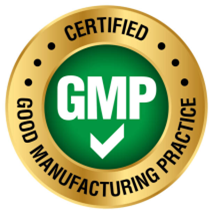
In many parts of the world, the production of pharmaceutical products, food and beverages is subject to the quality assurance guidelines of ‘Good Manufacturing Practice’ (GMP). Inspections are carried out by national regulatory agencies.
What makes a pump ‘hygienic’?
Materials
The pump, and particularly all wetted components, must be constructed from high quality materials and be safe for the intended process. Typically, high grade stainless steel is used (such as 316L) but, for more aggressive media, higher-grades may be necessary. Ferrite levels should be low (<1%) to minimise rouging (a discolouration of contact surfaces that occurs, particularly in high temperature processes – basically, a form of corrosion). Plastic components must be inert and approved for use with the intended medium.
Design and manufacture
It is important to minimise or preferably eliminate any areas where matter may collect and bacteria could develop. Wetted components should be smooth, free of defects such as scratches, and have no dead spaces where the feed can collect and stagnate, leading to bacterial growth. The pump should be free draining with no areas where product can collect or that are difficult to clean. Metal surfaces are typically electropolished for cleanliness and to reduce the risk of deposits collecting within the pump during use. Electropolishing involves the removal of a thin layer of metal from the pump components by electrolysis – in effect, ‘reverse plating’. The main advantages of the process are that it allows the polishing of complex, internal shapes and removes surface contaminants. A surface finish is measured by the Roughness Average, Ra - the average height between a surface’s microscopic peaks and valleys. Generally, the electropolishing process reduces roughness values (Ra) to sub-micron values. Pump manufacturers often quote an Ra value, with 0.8 micron being a standard electropolish finish and finer finishes optionally available (and often demanded for pharmaceutical applications).
Cleanability
To maintain high levels of hygiene, pumps and associated equipment must be cleaned regularly. All parts in contact with the transferred media must permit easy and efficient cleaning. This may be specified as CIP (Clean in Place), COP (Clean Out of Place) or SIP (Sanitize/Sterilize in Place) compatible design. CIP is a cleaning technique in which the entire system (including pumps, valves and pipework) can be purged with a cleaning solution without any disassembly. SIP involves steam injection or sterilisation. Potentially detrimental effects on seals or other process equipment must be considered. Pumps noted as COP require disassembly for cleaning. The low adhesion of electropolished surfaces improves draining and therefore cleaning efficiency. Hygienic pumps might incorporate disposable components to eliminate the need for cleaning and the risk of contamination from earlier use.
What types of pumps are ‘hygienic’?
A number of different pump technologies can be adapted for this purpose: centrifugal and positive displacement (such as rotary and reciprocating pumps). Rotary positive displacement pumps, such as lobe or circumferential piston pumps are preferred when the medium has a high viscosity, solids content or is shear sensitive. This type also has the advantage of being able to finely control output independently of feed pressure.
Centrifugal pumps
Centrifugal pumps are mechanically simple, easy to maintain and clean, and can be adapted to many different situations. They are the ideal choice for high flow rate transfer of low viscosity liquids. However, with high viscosity feeds, centrifugal pumps become increasingly inefficient and are prone to wear. A pumped medium that is sensitive to shearing (the separation of emulsions, slurries or biological liquids) can also be damaged by the necessarily high speed of the impeller in a centrifugal pump. In such cases, the lower speed of a positive displacement pump would be more appropriate. With centrifugal pumps, the shaft seal and its support system must be carefully designed. To achieve CIP/SIP capability, it must be possible to clean the seal and the construction materials used need to be resistant to the feed and any cleaning agents. If it is necessary to flush the seal chamber to maintain performance during operation, the fluid used must be compatible with the pumped medium.
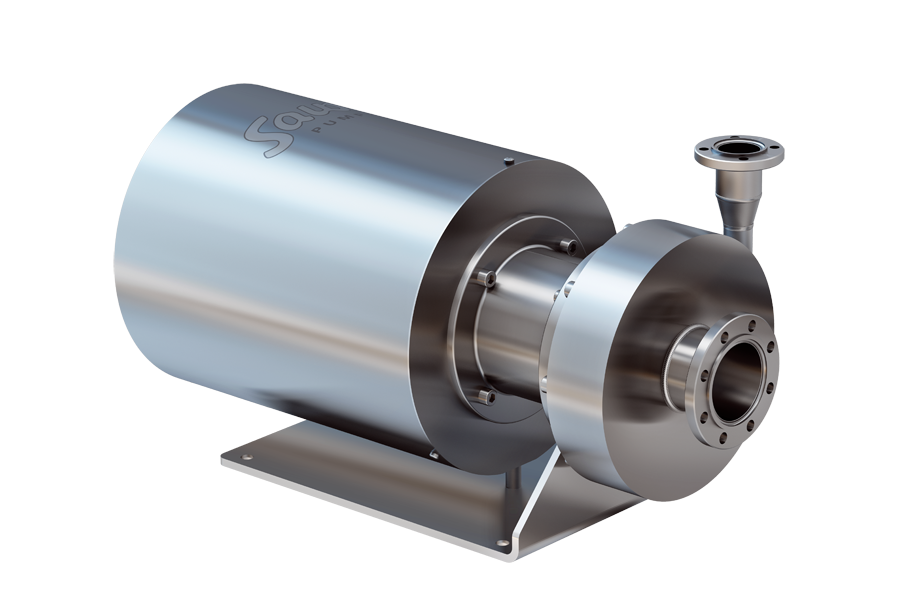
Sawa ZA/ZAL series hygienic centrifugal pump offering flow rates of up to 100 m3/h
Side channel pumps
Side channel pumps are similar to centrifugal pumps but have an ability to self-prime and to handle liquid/vapour mixtures. They provide a gentle and quiet pumping action and can cope with liquids containing gas or vapour. Hygienic versions are particularly suitable for transporting beverages, alcohols, oils, emulsions, and pharmaceutical products.
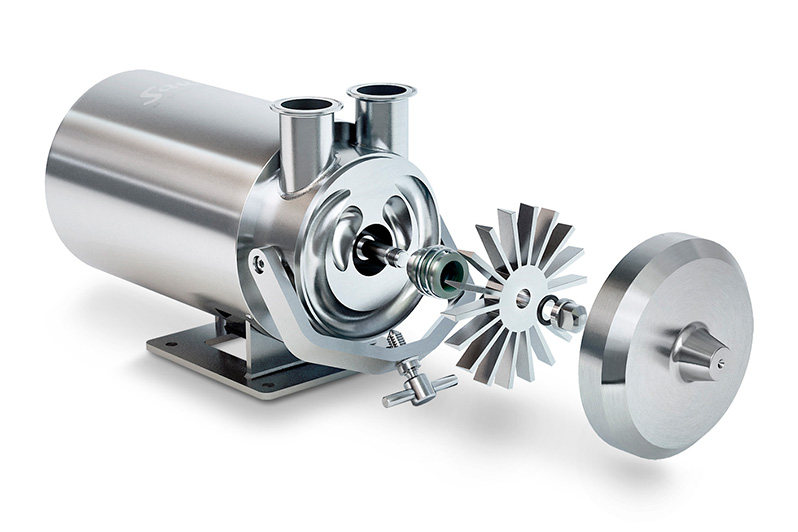
Sawa HD side channel pump: with electropolish finish to <0.4um, CIP & SIP compliant, dead space free design
Circumferential piston/ rotary lobe pumps
Circumferential piston pumps (CPP) and rotary lobe pumps are positive displacement pumps that share similar technology. Both utilise precise timing gears to ensure their rotors are non-contacting, which helps to limit wear regardless of viscosity. With low operating speeds, the gentle action of these pumps is ideal for transporting shear-sensitive liquids. They are designed to be disassembled for thorough cleaning but can also be fully CIP compliant. The pumps are self-draining and front access allows rapid seal changes and maintenance without taking the pump offline.
Diaphragm pumps
Air operated double diaphragm (AODD) pumps have a gentle, shear-sensitive pumping action. There are no seals between the wetted parts and the outside environment so leakage can only occur if one or both diaphragms fail. As part of a general maintenance programme, diaphragms should be replaced regularly, according to the manufacturer’s recommendations. The pump body is usually made of 316 Stainless Steel, although some models are completely non-metallic. Diaphragms must be approved for the intended use and are often made of PTFE or santoprene.
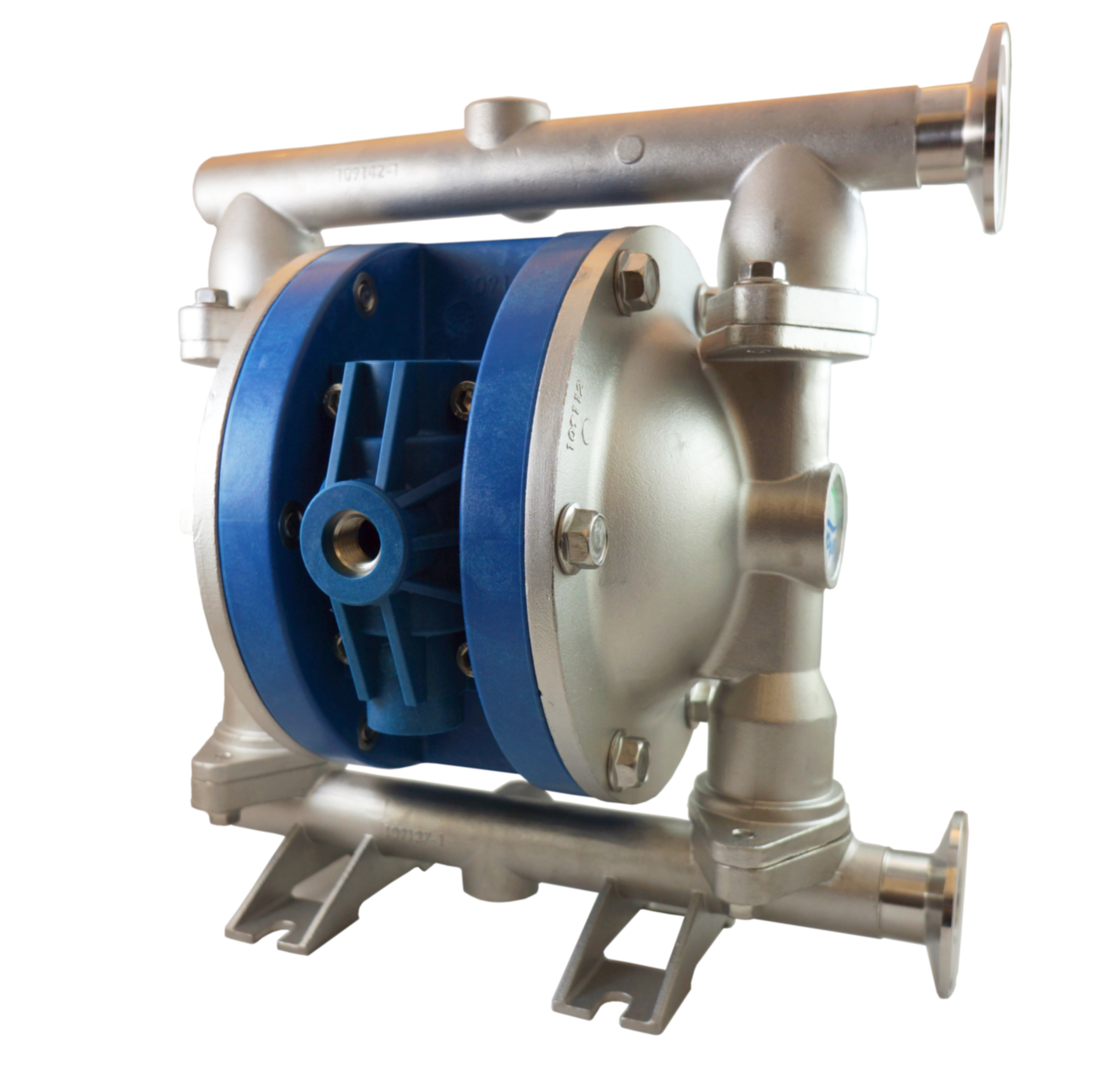
FTI-AIR’s FDA-compliant AODD pumps are specifically constructed of materials safe for food, beverage, pharmaceutical and cosmetic processes where 3A or EHEDG compliance is not required.
Making hygienic connections
Tri-clamp fittings (also called tri-clover fittings) have become the industry standard for leak-free hygienic connections. Pipework for tri-clamp connections terminates in a flange incorporating a concentric groove. To make a connection, a gasket, with a ridge on each side to match the flange grooves, is clamped in place. The clamp is hinged and fits around the flanges, pulling them together against the gasket. By carefully matching the flanges and gasket, a leak-free connection is obtained with no dead space, ridges or defects. Tri-clamp connections are easy to connect and disassemble. There are no male-female threads so no spanners are required. Gaskets are available in a range of materials to fully comply with any regulatory requirements. There are a number of alternative connection systems in use. I-Line fittings are similar to tri-clamps but have a different flange design. DIN 11851 fittings and Bevel Seat fittings are screw fittings incorporating a gasket seal.
Summary
Hygienic pumps are specifically designed for use in the food and beverage, pharmaceutical, cosmetics and biotechnology industries. They are manufactured to the highest standards to have no defects or dead-spaces where bacterial growth may occur, to drain freely, and to enable easy and thorough cleaning or sterilisation. Hygienic pumps and their components should carry certificates of compliance with the manufacturing and design standards of a number of US and European agencies: FDA, 3A and EHEDG.

